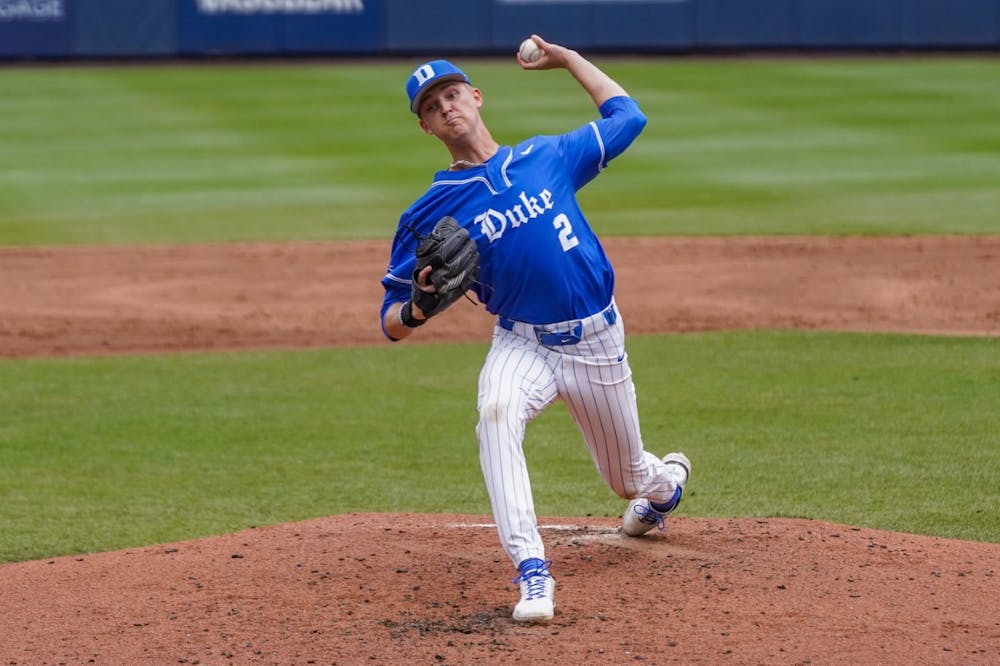In April, the Blue Devils were in the middle of a 15-3 stretch that saw them climb into the top 10 nationally. In March, they struggled to string together consistency near the bottom of the conference. And in February, no one had any expectations for an inexperienced Duke team with plenty of question marks.
Today, while head coach Chris Pollard has engineered a team performing far beyond its expectations, questions still remain. The Blue Devils faltered at the end of the regular season, dropping two series they were in every position to win: First a home series against then-bottom-of-the-conference Georgia Tech and then an away bout against Miami that they were one strike away from winning. They limped into the ACC tournament, only to lose their first game to N.C. State 8-7 in extra innings.
So, while Duke has shown its capability to compete against any team in the country, the margin of error for this team is razor thin.
The difference between the Blue Devils’ red-hot April and lukewarm May was not anything drastic; even an injury to All-ACC freshman Andrew Fischer did not stop Duke from thoroughly beating then-No. 11 Virginia. Rather, small miscues began to accumulate. The team started leaving more runners on base (26 alone in the Georgia Tech series), pitchers weren’t as sharp and a usually solid defense became porous.
A major reason these mistakes amplified into a noticeable decline is the structure of the team’s pitching staff. Due to a preseason injury to Luke Fox and an early-season injury to Jonathan Santucci, Pollard has relied on a pitch-by-committee approach, rarely using a pitcher for more than three innings at a time. While this tactic worked beautifully for Duke throughout the season — it finished the regular season with the seventh-best ERA in the nation at 3.94 — it also drastically increased the volatility of its gameplan.
Take, for example, the last game of the Blue Devils’ regular season, a pivotal matchup against Miami. A day removed from a heartbreaking extra-inning loss, Pollard had to put together a plan to attack the Hurricanes while resting a number of arms. So, when a storm delayed the game for over an hour after the first inning and forced starting pitcher Ryan Higgins out of the game, Duke had to adapt on the fly. The outcome was not pretty, a 10-1 loss that revealed a glaring problem for the Blue Devils.
The damage did not stop there, as Duke still felt the aftereffects of the weekend in its ACC tournament game against the Wolfpack. With a number of his most reliable pitchers taxed and still more resting for the upcoming NCAA tournament, Pollard turned to a strikingly similar set of arms as he did in the team’s game-two loss to Miami. Freshman Aidan Weaver, junior Adam Boucher, freshman Owen Proksch, graduate student Charlie Beilenson, sophomore Jimmy Romano and senior Jason White all threw for the Blue Devils in both games.
The only pitcher who threw against Miami but not against N.C. State was freshman James Tallon, Duke’s shutdown closer who finished the regular season with a 0.85 ERA. Pollard said after the game that Tallon was not available because he needed rest from the weekend, but his absence was certainly felt.
Looking ahead to the NCAA tournament, in which Duke will need to play multiple high-stakes games on consecutive days, the team cannot afford to lose because of extra-innings or the rain.
On the brightside, it has shown the ability to weather a storm. The Blue Devils survived, and thrived, in April when they had three straight ranked series with significant midweek games in between.
In the middle of this stretch came a three-game series against then-No. 13 Louisville. Duke won each game by one run, and two via a walkoff hit in the ninth inning. However, those games could easily have gone the other way if the lineup had not stepped up.
Tallon very nearly cost the Blue Devils when he gave up a game-tying, two-run home run in the eighth inning of game two. Thankfully, junior Alex Stone came through with a walk-off single to reclaim momentum of the series. A similar outcome came in game one, when two Louisville runs off Boucher gave the Cardinals a three-run lead in the ninth before sophomore Alex Mooney found a miracle in a walk-off grand slam.
So, as much as the responsibility lies on the pitching staff, mistakes are bound to happen. When they do, the lineup has to be capable of responding, just as it did against Louisville. However, in its four recent losses to Georgia Tech and Miami, Duke scored just one run total in the seventh inning or later. A game-tying home run in the bottom of the ninth against N.C. State from graduate student MJ Metz seemed to give the needed spark, but the Blue Devils failed to produce a run in extra innings.
Interestingly, Duke’s strength is also its weakness. Pollard’s pitching strategy has allowed the team to prosper despite its holes, but it has also tightened the window for success. Whether or not the Blue Devils advance past NCAA regionals or beyond will depend on the planning and execution of their wide array of arms, and the ability of the bats to respond when things go wrong.
Get The Chronicle straight to your inbox
Sign up for our weekly newsletter. Cancel at any time.
Dom Fenoglio is a Trinity junior and a sports managing editor of The Chronicle's 120th volume.

